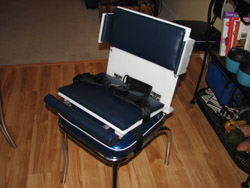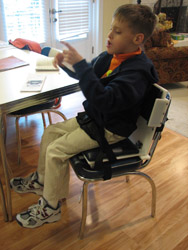Client Coordinators: Nancy Curtis, Keri McCauley
Designers: Kristen Bova, Matt Hoover, Jesse Sandberg
Supervising Professor: Larry Bohs
 INTRODUCTION
INTRODUCTION
Our client, an eight-year-old boy diagnosed with autism and cerebral palsy, can sit in a chair independently but needs help correcting his posture. Specifically, he needs assistance with proper hip placement and lateral trunk and spine support. We constructed the Portable Support Seat using high density polyethylene plastic (HDPE). The seat includes a hip belt and small side supports, and allows for adjustments to the seat angle as well as the seat depth. The Portable Support Seat is lightweight and can be easily and efficiently attached to a wide variety of chairs using secure and safe lock straps. The device folds in half for easy transport and storage.
Our client can now sit at the dinner table with proper and optimum posture. He no longer pushes his hips forward nor falls off the side of his chair. Since he is fully upright and able to have both arms on the table, he is more actively engaged in dinnertime activities, and his parents now have an easier time bringing him out to dinner with the rest of the family. According to our client’s mother, “I am looking forward to taking our new chair on vacation with us to Disney World!”
 TECHNICAL DESCRIPTION
TECHNICAL DESCRIPTION
The frame of the Portable Support Seat (Figure 1) is made of two rectangular blocks of ½” HDPE. The seat bottom is 14.5”x12”x0.5” and the vertical back support is 14”x15”x0.5”. The seat and back support are connected with two 16 in-lbs. torque friction hinges. The vertical back support is mounted on a bottom support base of HDPE that is 16”x2”x0.5”. The back support is screwed into the support base with five 1.5” 10-32 flat head screws.
A length-adjustable padded lap belt is attached seven inches from the back of the seat bottom. Four webbing straps attach the seat to a supporting chair: two on either side of the underside of the seat bottom and two on the back of either side of the vertical back support. All of the webbing straps attach together via squeeze-release buckles. The straps are adjustable in length to allow for various seat sizes and to accommodate for the client’s continued growth. Adjustable feet are mounted on 1.25”x1.5”x1.25” blocks of HDPE at the four corners of the seat bottom. The adjustable feet have heads that rotate and non-slip rubber bottoms. Each can be retracted and extended from its supporting HDPE block, thereby changing the angle between the seat and back of the chair.
On the underside of the seat bottom, a system is built into the chair to that allows the necessary adjustments to optimize the user’s proper knee placement at rest. The adjustment system consists of two quarter- inch deep and half-inch wide milled square channels. In each channel, a 5.25”x0.5”x0.5” aluminum bar is positioned to slide through the channel. The two slide bars are connected by a 14”x0.5”x0.5” extension cross bar. This cross bar is padded with pipe insulation and covered with vinyl. The slide bars stay in place using two 1.5”x5”x0.5” blocks of aluminum. Each block has a 0.25” inch deep and 0.5” wide square channel milled vertically along its center. The milled channels in the aluminum support bases are each fit over one slide bar and screwed into the HDPE seat bottom. Each slide bar is held in place by two 0.25” set screws when the bars are in the proper position.
One and a half inches down from the top of either side of the vertical back support are two 3”x5.5”x0.25” HDPE lateral supports, which help support the client’s trunk from side-to-side motion. A 0.25” deep and 5.5” long slot is milled into either side of the vertical back support. A 1”x5.5”.0.25” HDPE side support extender is fit into each slot. The lateral supports are aligned with these side support extenders and the entire side support system is screwed in place.
Lastly, the seat bottom, vertical back support, and lateral side supports are all covered with padded cushions. The seat cushion is 14”x10.75”.0.25”, the vertical back cushion is 14”x7”x0.25”, and the side cushions are each 5”x2”x0.25”. The cushions are constructed from ¼” plywood and layers of cotton sheets. They are wrapped in navy vinyl that is attached to the plywood with ¼” staples. Each cushion is attached to the HPDE via Velcro.
The Portable Support Seat weighs 12.5 lbs. Figure 2 shows our client in the device at the dinner table. The replacement cost is $260.